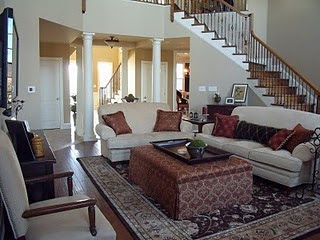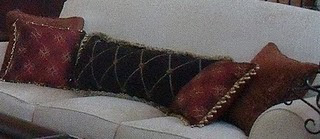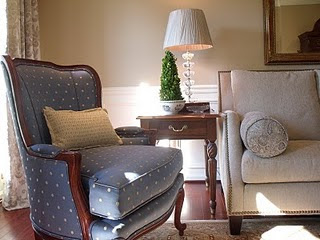Pillow Power
Oh that poofy little thing! Your head happily rests upon one while you slumber and dream your dreams. One supports my lower back as I work at my desk in my cozy little design studio. And as a designer – I manipulate spaces using these little gems because they allow me to lead the eye by moving color, or pattern – or both – through a room, to particular effect. I can update an old sofa using their morphing presence – almost completely changing the feeling of its upholstered form. I can make a room feel cozy and lush with them – or elegant and upscale with them – or whimsical and feminine – or – well, you get the idea. Enter….the Pillow!
Historically speaking, pillows were originally used by the wealthy and have been found in Egyptian tombs. The ancient Egyptians believed the head to be a sacred part of the body, (They never met some of the frat boys I knew in college). They thought the head to be the center of wisdom and vitality and so concluded that it should rest upon ornately adorned pillows. In Europe, long cylindrical bolster pillows were placed between the headboard and mattress to give the resting pillow something to lean on. And so from this, it became a common practice to sleep in a semi-reclined position. Skootch over to Asia and you’ll find a different take. It was thought that soft pillows might somehow deplete the body’s vital force and energy. (Maybe that’s been my problem all these years . . I thought it was motherhood.) Thus in Asia, the pillow was made from hard materials such as leather, wood (ouch) and ceramics. Pictured here is a swirled ceramic Song Dynasty Pillow from China. And to protect the elaborate hairstyles, (This a girl may be able to relate to…) something called the ‘tall pillow’ was created. Shown here, and noted as China circa AD 907-1127.
A tall pillow in essence was a stand for the neck made of wood or other carved material that held the neck so the hair could hang freely and undisturbed. This is certainly a little accoutrement that my 5-year-old self would have loved to had access to in New York, circa 1967, in order to preserve the extensive up-do my mother had coiffed on my small head for oldest brother’s bar-mitzvah. That ‘do’ made me feel like a million 6-year-old bucks, but atlast – it did not survive my bed rest that evening after the event. Thus concludes our brief foray into the history of pillows – and a small look at my ‘do’ history.
Back to how to use pillows today:
Notice the full room photo above – or the close up here. In this family room I did,shown in full photo abovein it’s “not-completely-finished form.” My client needed a great sense of coziness. The challenge was her disceptively long, narrow, 2-story family room. (In the full photo – you are seeing only one area of the long room). Important to note is that all of my client’s inspiration photos showed not only pillow filled interiors, but also endless small, cozy nooks. How to translate ‘cozy-nook” into a 2-story large scale space: among my many specific choices, enter the pillow.
Here an over-sized oblong pillow in velvet is trimmed in a brush fringe. Flanking it are smaller pillows with an embroidered fabric with a nice contrasting sheen and trimmed in a ball-tassel fringe. Self corded woven Jacquard pillows complete the vignette. What you see are lush, divergent textural combinations and a resulting coziness. That was this designer’s intention – as was moving the cranberry color through the length the space – as well as lifting a dash of the chocolate from the rug up onto the sofa to create depth – all accomplished with pillows. Be warned: the down side to a pillow filled sofa – for all of my neat-Nellies out there – is that you will be moving them to accommodate how you want to sit on the sofa and rearranging them as a practice.
Here are some pillows & tips for you to consider in your design quest. At retail, you can pick them up for as little as 2/$24. Custom pillows can easily top $100-$150 – or more – but trust me. The interiors you’re admiring in the design magazines rarely sport pillows from retail. And when the do – it’s by one of us savvy designers who mix a few in amongst the custom pieces of pillow art.
The Bolster: A cylindrical pillow. SO (!) smart looking on either of a sofa at the arm as shown in this living room I did. These are often shown in the highest end of the furnishings world. They make any sofa look more expensive and do not need to be moved to sit on the sofa when they used on sofas with restrained arms like this one.
The Kidney: Also shown in this detail shot is a kidney pillow that provides nice color movement on a chair as well as nice back support for the sitter to ajdust. Kidney’s are rectangular pillows.
The Oblong: Think of a kidney….on steriods. The large brown pillow in my opening shot is an oblong.
The Square. These are the easiest to find at retail. Done in custom, you can have great fun by fringing, bordering, banding, and so forth.
The Bean Bag. Wonderful for teenage bedrooms, media rooms, rooms where some folks will perch up on the upholstery, and some will flop on the floor. Watch for adequate fill so your bean bag doesn’t become a pancake bag and please watch for child safety.
Some things to consider to get great mileage out of your pillows:
1. Vary shapes and sizes for impact. (All 17″ square pillows makes Jack a dull boy.)
2. Put your bold pattern, your trend patterns or your trendy colors on these…you can change them out much easier than a sofa.
3. Vary textures – not only among the pillows themselves, but also as a contrast to the upholstery or bed they sit on. (ie…on leather upholstery, go for chenilles and velvets in your pillows to create rich warmth)
4. Try doing just one fantastic pillow on a sofa – dead center. I have a great fringed kidney in my studio here sitting center stage on my sofa. Dramatic, easy to sit around – and though custom – you’d only need one. I just saved you some money, my new pillow pal.




